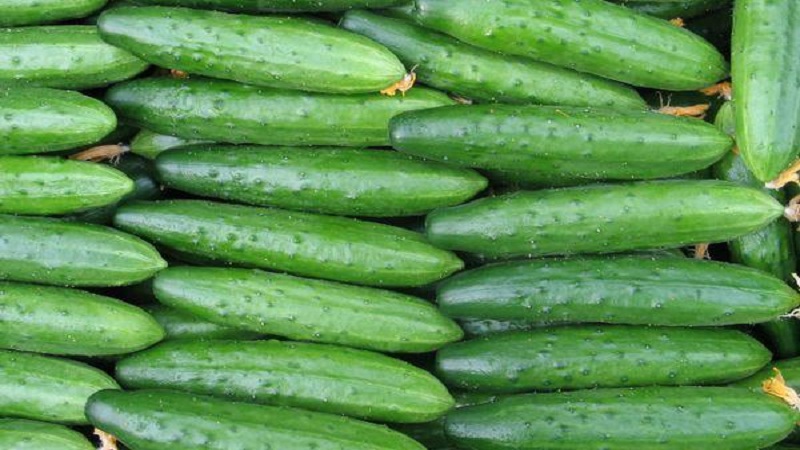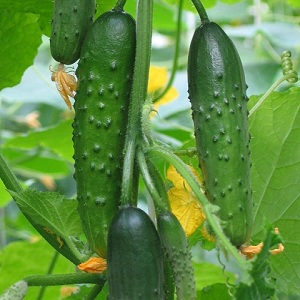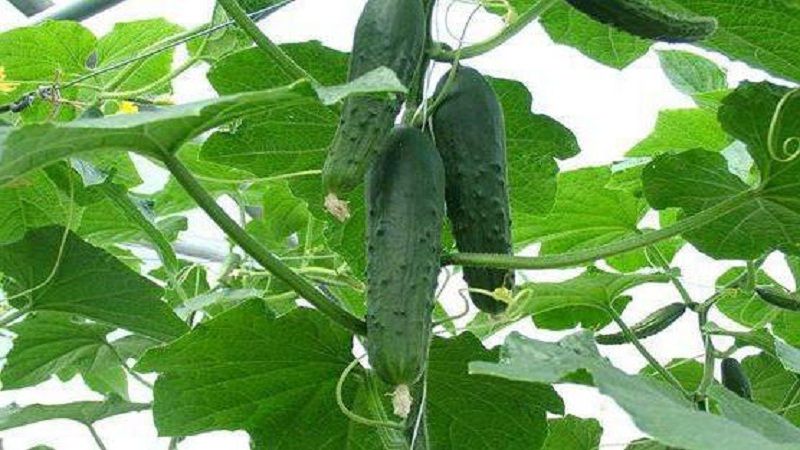Review of the hybrid cucumber "Emelya": advantages and disadvantages, care features
Hybrids are popular in the seed market due to their unpretentious care, resistance to bad weather, infectious diseases and long-term fruiting. One of them is Emel's parthenocarpic f1. The culture is suitable for growing in all regions of the country, adapts to any growing conditions, is characterized by an early ripening period and high productivity.
We have prepared for you information about the nuances of agricultural technology of these cucumbers, their advantages and disadvantages.
The content of the article
Description of the variety
Emelya f1 - a product of the selection work of biologists of the domestic seed company "Manul"... It is included in the State Register of Russia in 2002 as a hybrid intended for growing in greenhouses and hotbeds.
The bushes are indeterminate, vigorous, medium branched, with a female flowering type. The laying of the ovaries is bundle.
The culture is cold-resistant, with amicable fruiting. 7-10 fruits are formed in one leaf node.
In the photo - Emelya's cucumbers.

Distinctive features of the hybrid are shown in the table.
| Indicators | Characteristic |
| Ripening period | 39-43 days |
| Pollination type | Parthenocarpic |
| Weight | 120-150 g |
| Length | 13-15 cm |
| The form | Fusiform |
| Coloration | Green with light stripes |
| Leaves | Medium size, green color, slightly wrinkled, with slightly wavy edges |
| Pulp | Dense, crispy, no voids |
| Taste | Sweetish, without bitterness |
| Skin | Thin, with small sparse tubercles and white pubescence |
| Appointment | Universal |
| Yield | 12-16 kg / m² |
| Sustainability | To cucumber mosaic virus, olive spot |
| Transportability | High |
Composition, calorie content and benefits
Nutritional value of cucumbers (per 100 g):
- calorie content - 14 kcal;
- proteins - 0.8 g;
- fats - 0.1 g;
- carbohydrates - 2.5 g;
- water - 95 g;
- fiber - 1 g.
Cucumbers are also rich in vitamins and minerals - see the table for details.
| Name | Content | Norm |
| Vitamin A | 10 mcg | 900 mcg |
| Beta carotene | 0.06 mg | 5 mg |
| Vitamin B1 | 0.03 mg | 1.5 mg |
| Vitamin B2 | 0.04 mg | 1.8 mg |
| Vitamin B4 | 6 mg | 500 mg |
| Vitamin B5 | 0.27 mg | 5 mg |
| Vitamin B6 | 0.04 mg | 2 mg |
| Vitamin B9 | 4 μg | 400 mcg |
| Vitamin C | 10 mg | 90 mg |
| Vitamin E | 0.1 mg | 15 mg |
| Vitamin H | 0.9 μg | 50 mcg |
| Vitamin K | 16.4 μg | 120 mcg |
| Vitamin PP | 0.3 mg | 20 mg |
| Potassium | 141 mg | 2500 mg |
| Calcium | 23 mg | 1000 mg |
| Silicon | 53 mg | 30 mg |
| Magnesium | 14 mg | 400 mg |
| Sodium | 8 mg | 1300 mg |
| Sulfur | 6.5 mg | 1000 mg |
| Phosphorus | 42 mg | 800 mg |
| Chlorine | 25 mg | 2300 mg |
| Iron | 0.6 mg | 18 mg |
| Iodine | 3 μg | 150 mcg |
| Manganese | 0.18 mg | 2 mg |
| Copper | 100 mcg | 1000 mcg |
| Selenium | 0.3 μg | 55 mcg |
| Fluorine | 17 mcg | 4000 mcg |
| Chromium | 6 μg | 50 mcg |
| Zinc | 0.215 mg | 12 mg |
Benefits for the body:
- lignans and cucurbitacins destroy cancer cells, reduce the risk of oncology;
- vitamin K maintains the strength of the skeletal system;
- potassium strengthens the cardiovascular system;
- fiber normalizes the digestive tract;
- vitamin C whitens freckles and age spots.
Hybrid agricultural technology
Emelya's cucumbers are grown by direct sowing of seeds into the ground and through seedlings. Care includes frequent loosening, weeding of weeds, watering, mineral and organic fertilizing, maintaining optimal temperature and humidity in the greenhouse, forming bushes and tying to the trellis.
Seed planting
Direct sowing into the ground is carried out when it warms up to + 18 ° С, and the air - to + 23 ° С. The culture grows well in light, loose and nutritious soil with neutral acidity (pH = 6.5-7).To check, use litmus strips, which are sold in gardening stores. Lime, dolomite flour, wood ash, chalk help to normalize acidity.
Seeds without a colored shell are etched in a 1% solution of potassium permanganate (1 g / 100 ml of water) and soaked in "Epin" or "Zircon" growth stimulators.
The timing of sowing is determined depending on the climatic zone: in the southern regions - in the first decade of May, in the regions of the middle zone - in the third decade of May or in the first decade of June.
The soil is pre-loosened and fertilized with a mullein solution (10 l / 1 m²).
A bayonet shovel is used to form beds 70 cm wide and 20 cm deep. Then the area is leveled with an iron rake. A 1-2 cm depression is formed in the middle and filled with a hot dark solution of potassium permanganate.
After laying the seeds, the furrows are sprinkled with moist soil or peat. Black agrofibre is pulled from above to protect against low temperatures, maintain humidity and friendly seedlings.
The shelter is removed after the sprouts appear. The beds are thinned out by pinching weak seedlings.
Seedling planting
Work on growing cucumber seedlings begins 20-30 days before transfer to a permanent place... Sowing technology is standard for all cucumbers.
The pickled seeds are embedded in a substrate made of humus, peat and river sand in a 2: 2: 1 ratio. The soil is disinfected with a strong solution of potassium permanganate, "Fitosporin", heated in an oven at a temperature of + 110 ° C or in a double boiler for 20-30 minutes.
Council. Germinate the seeds on a damp cotton cloth for 2-3 days before sowing seedlings.
For growing seedlings of cucumbers, peat pots with a volume of 0.5 liters are used. This reduces the risk of damage to the weak root system, because the sprouts can be planted in the holes without removing them from the containers.
The container is filled with a moist substrate and one germinated grain is sealed to a depth of 1-1.5 cm. A plastic wrap is pulled from above and left in a warm room.
It is removed after germination and taken out to the lightest windowsill in the house. For irrigation, use warm spring or settled water. Watering frequency - 1 time in 7 days. Seedlings are inspected for weak specimens and cut with scissors.
Dive it to a permanent place at the stage of 3-5 true leaves. Planting scheme - 20x70 cm, 3 bushes per 1 m². They try not to deepen the roots so as not to provoke infection of the bushes with root rot.
Care
The agrotechnics of the Emelya f1 hybrid has no fundamental differences from the care of other parthenocarpics. The density of planting seedlings in the greenhouse is 2.5 bushes per 1 m², in the garden - 3-4 bushes per 1 m².
Installing a drip irrigation system makes it easier to care for the crop. Through it, a regular supply of water and liquid mineral fertilizers is provided.
The bushes are watered manually from a watering can at the root, trying not to get on the leaves. Watering is done in the morning or evening to prevent sunburn.
Important! Do not forget to loosen the soil after each watering and weeding of weeds. Mulch will help to reduce the amount and frequency of weeding: the beds are covered with hay, straw, sawdust or needles.
The culture is grown on a trellis to create additional ventilation and efficiently use the space in the greenhouse and in the garden.
Cucumbers are fertilized at least 4-5 times a season with minerals and organics. The table shows an indicative feeding scheme depending on the stage of development.
| Stage of development | Fertilizer |
| Before flowering | 400 ml of liquid chicken manure per 10 liters of water. Use once after planting for root watering |
| During flowering | 1 tsp urea, superphosphate, potassium sulfate per 10 liters of water. Water the bushes 10 days after the first feeding |
| During fruiting | 25 g nitrophoska, 20 g chicken droppings / 10 liters of water. Water the cucumbers 10 days after the second feeding |
| To prolong fruiting | 10 g potassium sulfate, 500 ml cow dung / 10 l.Water the bushes under the root |
| 10 g urea, 6 g potassium sulfate / 10 l water. Spray plants in cloudy weather |
Features of cultivation and possible difficulties
Emelya's cucumbers are resistant to cold weather - the bushes bear fruit even at low air temperatures.
The main stem of the hybrid has an unlimited growth point, but the fruits are formed not only on it, but also on the shoots. Each of them grows 7-10 cucumbers.
Since parthenocarpic plants are prone to a rapid green mass gain, without proper shaping, the plant will not be able to achieve abundant fruiting. All the growth energy will be spent on forming foliage and shoots, not fruits.
Forming rules:
- remove all shoots and flowers in the axils of the first five leaves;
- leave six stepchildren 20-25 cm long;
- pinch a few stepsons above and leave a length of 35-40 cm;
- tie the main stem to the trellis, pinching the top of the head, or wrap it around the crossbar several times, stopping the growth point.
An important rule for caring for cucumbers is to maintain humidity in greenhouses at a level of 75–80%, air temperature - from +22 to + 28 ° С.
At low humidity, fruit development slows down, the leaves begin to dry and age quickly, and the fruiting period decreases. With high humidity, fungal infections develop, roots and fruits rot.
To increase it, containers with water are installed in the greenhouse, while the doors and vents are kept open. Airing the room will help to reduce the humidity level.
If the air temperature drops to a critical level of + 8 ° C, the plantings are covered with white agrofibre.
Diseases and pests
The hybrid is resistant to olive spot, cucumber mosaic virus, root rot and powdery mildew. Planting is often attacked by aphids, spider mites and whiteflies. The table contains signs of diseases and damage by insects, methods of dealing with them.
| Disease / pest | Signs | Treatment |
| Powdery mildew | White-yellow bloom on stems and leaves, small brown balls, dew drops on greenery, dry leaves twisted up | 1 liter of curdled milk, whey or kefir per 10 liters of water. The number of treatments is not limited.
1/3 teaspoon of soda ash, 25 ml of liquid soap in 1 liter of water. Process planting once every seven days |
| Root rot (pythium rhizoctonia, fusarium) | Watery, slippery, dark spots on the leaves, wrinkled dark brown leaves, destroyed tissue of the root collar and main root | Treatment with drugs: "Gamair", "Planriz", "Baktofit", "Trichodermin", "Pseudobacterin-2" |
| Spider mite | Small white dots on the back of leaves, thin cobwebs on bushes | 50 g of greens and dandelion flowers / 2 l of water, leave for 3-4 hours and spray the bushes |
| Aphid | Dropped leaves, drops of honeydew, large concentrations of ants | Pour 500 g of dry grass with 10 liters of water. Leave in a warm place for 48 hours. Treat the plants with a spray bottle |
| Whitefly | Sticky bloom on stems and leaves, many white larvae at an early stage and schools of white moths at a later stage. | Chop 300 g of garlic and pour 1 liter of warm water. Close the container with a lid and leave for five days |
Disease prevention measures:
- disinfection of the site with a concentrated solution of potassium permanganate, copper sulfate;
- humidity level control;
- compliance with watering rules;
- destruction of infected bushes;
- crop rotation;
- sowing siderata.
Harvesting and application of the crop

Fruit collection begins 1.5 months after full sprouting. The culture is characterized by long-term fruiting and a friendly return of the harvest.
Cucumbers do not outgrow, do not barrel, are suitable for fresh consumption and preservation. Dense and crispy pulp does not soften during heat treatment, no voids are formed inside.
The fruits tolerate transportation well, keep fresh in a cool place for about three weeks.
Advantages and disadvantages
Hybrid advantages:
- high productivity;
- thin skin and sparse thornless tubercles on the surface of the fruit;
- excellent sweetish taste without bitterness;
- disease resistance.
Disadvantages:
- predisposition to powdery mildew and root rot;
- the need to form bushes.
Reviews
Many gardeners prefer the Emelya hybrid due to its cold hardiness, strong immunity and fertility.
Anna, Ryazhsk: “Emelya settled in my greenhouse three years ago. The culture is unpretentious in care, the fruits ripen almost simultaneously and in large quantities, do not outgrow, and are stored for a long time. Taste quality is excellent. Cucumbers are good both in fresh salads and in a jar of brine. "
Olga, Kemerovo: “I chose cucumbers for the greenhouse, focusing on the climate of our region. I opted for Emela and was right. The culture tolerates the cold, but I still cover the plantings with agrofibre when the temperature drops sharply. The pulp is dense, juicy, not bitter. I feed the bushes with mullein, potassium and phosphorus. "
Conclusion
Emelya's parthenocarpic hybrid is suitable for indoor cultivation. The culture does not need additional pollination by bees, adapts to any climate, forms ovaries at low air temperatures. The plant has strong immunity to olive spot, cucumber mosaic virus.
If you follow the rules of agricultural technology, you will certainly be able to get a tasty and rich harvest. We wish you a rich and tasty harvest!